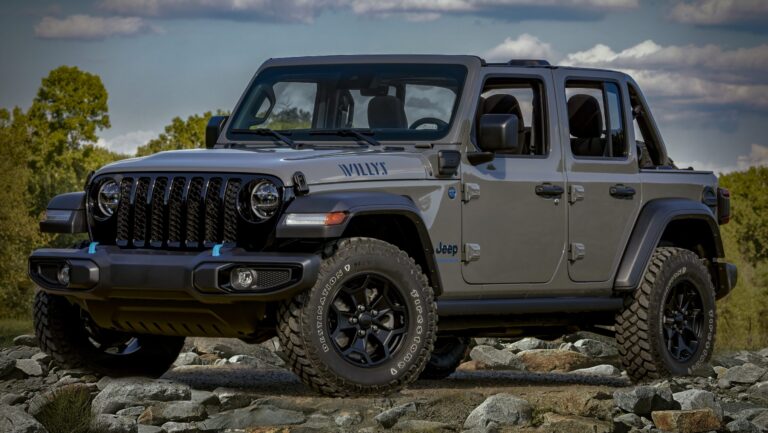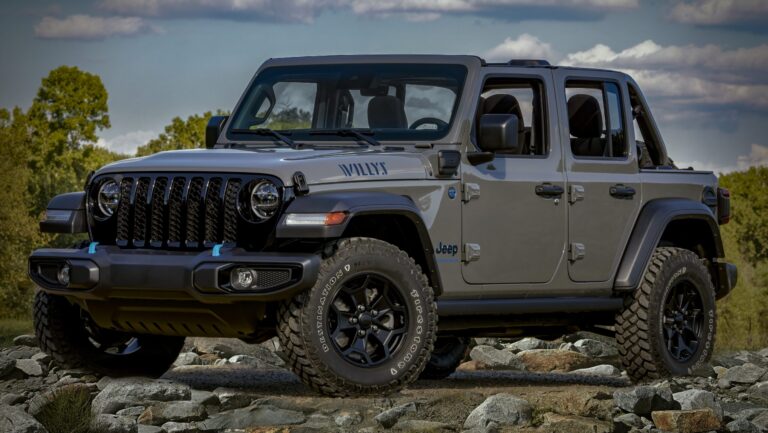Old Postal Service Jeep For Sale: Your Comprehensive Guide to Owning a Piece of American History
Old Postal Service Jeep For Sale: Your Comprehensive Guide to Owning a Piece of American History jeeps.truckstrend.com
Introduction: The Enduring Charm of the Postal Jeep
The sight of a bright white, right-hand drive (RHD) Jeep navigating rural roads was once a common fixture across America. These were the workhorses of the United States Postal Service (USPS), specifically the Dispatcher Jeeps, more commonly known as "Postal Jeeps." For decades, from the 1950s through the late 1980s, these robust, utilitarian vehicles, primarily the DJ-3A, DJ-5, and DJ-5M models, reliably delivered mail to every corner of the nation. Today, the "Old Postal Service Jeep for Sale" represents more than just a used vehicle; it’s an opportunity to own a unique piece of American automotive and social history.
Old Postal Service Jeep For Sale: Your Comprehensive Guide to Owning a Piece of American History
These distinctive Jeeps, often characterized by their sliding doors, RHD configuration, and two-wheel drive, were built for a singular purpose: efficient mail delivery. Their simple design, robust construction, and compact size made them ideal for navigating diverse routes, from bustling suburban streets to winding country lanes. While their active service days are largely behind them, a vibrant community of enthusiasts, collectors, and customizers now seeks out these iconic vehicles. Whether you’re looking for a nostalgic restoration project, a unique base for a custom build, or simply a conversation-starting daily driver, understanding the nuances of buying and owning an old Postal Jeep is crucial. This comprehensive guide will delve into everything you need to know about finding, evaluating, and enjoying an Old Postal Service Jeep.
The Enduring Legacy: What is an Old Postal Service Jeep?
The lineage of the Postal Jeep begins with Willys-Overland, the original manufacturer of the iconic military Jeep. The civilian versions, dubbed "Dispatcher Jeeps" (DJ), were designed to be economical, easy to maintain, and capable of handling continuous stop-and-go driving.
- DJ-3A (1955-1965): Based on the CJ-3A chassis, these early models often featured the "Hurricane" F-head four-cylinder engine. They were typically soft-top or metal-top enclosed vehicles.
- DJ-5 (1965-1983): This is perhaps the most iconic and recognizable Postal Jeep. Built on a modified CJ-5 chassis, the DJ-5 series saw numerous iterations and engine changes over its long production run. Key features included the RHD setup, often a single driver’s seat, an automatic transmission, and frequently sliding side doors for quick access. Later models (DJ-5A through DJ-5M) saw engine changes from the Hurricane to the AMC-designed OHC 153 (four-cylinder), then the AMC 232 or 258 cubic inch inline-six, and finally the GM "Iron Duke" four-cylinder.
- DJ-8 (1970s): A longer-wheelbase version of the DJ-5, offering more cargo space, though less common than the DJ-5.

These vehicles were purpose-built, meaning they often lacked creature comforts like air conditioning, power windows, or even passenger seats. Their primary focus was utility and durability, which contributes to their appeal as a robust and relatively simple classic vehicle today.
Why Buy an Old Postal Service Jeep Today?
The appeal of an old Postal Jeep extends beyond mere transportation. It’s a blend of nostalgia, practicality, and customization potential.
- Nostalgia & Collectibility: Owning a Postal Jeep is owning a tangible piece of American history. For many, it evokes memories of childhood, of waiting for the mail, or simply of a bygone era. They are unique, easily identifiable, and attract attention wherever they go.
- Project Vehicle Potential: Due to their simple, body-on-frame construction, Postal Jeeps are excellent candidates for customization. From engine swaps (V6s, V8s, or modern four-cylinders are popular) and suspension upgrades to complete body modifications for off-roading, street rods, or even unique commercial vehicles, the possibilities are vast.
- Niche Practicality: For specific uses, the RHD configuration can be genuinely practical. Rural mail carriers, newspaper delivery drivers, or those who frequently drive on the shoulder for specific tasks find the RHD setup incredibly convenient. They also make excellent, compact utility vehicles for farms or large properties.
- Relative Affordability: Compared to many other classic Jeeps (like a fully restored CJ-5 or CJ-7), a Postal Jeep can often be acquired for a more accessible price, especially if it’s a project vehicle. This makes them a great entry point into classic car ownership.
- Simplicity of Design: With fewer complex electronics and systems than modern vehicles, many repairs and maintenance tasks can be performed by a competent DIY mechanic, reducing ownership costs.
Navigating the Market: Where to Find Them
Finding an old Postal Jeep requires a bit of detective work and patience, as they are not as common as mainstream classic cars.
- Online Marketplaces: Websites like eBay Motors, Craigslist, and Facebook Marketplace are primary hunting grounds. Set up search alerts for "Postal Jeep," "DJ-5," "Willys Dispatcher," or "Jeep RHD."
- Specialized Forums & Classic Car Websites: Enthusiast forums dedicated to Jeeps or AMC vehicles often have classified sections. Websites like Hemmings Motor News, ClassicCars.com, and Bring a Trailer occasionally feature well-preserved or customized examples.
- Government Surplus Auctions: While less common now for the DJ-5 specifically, some government or municipal auctions might still turn up old utility vehicles.
- Local Classifieds & Word-of-Mouth: Check local classified ads, bulletin boards, and talk to mechanics or classic car club members in your area. Sometimes, the best finds are hidden in plain sight.
- Salvage Yards/Junkyards: For parts or a deeply discounted project, salvage yards specializing in older vehicles can be a goldmine, though finding a complete, restorable vehicle is rare.
When searching, be prepared to travel or arrange for shipping, as these unique vehicles are spread across the country.
What to Look For: Essential Inspection Checklist
A thorough inspection is paramount when considering an Old Postal Service Jeep for sale, as their working lives often left them with significant wear and tear.
- Rust, Rust, Rust: This is the number one enemy. Inspect the frame rails (especially near spring hangers and body mounts), floor pans (front and rear), rocker panels, wheel wells, and behind the sliding doors. Superficial surface rust is manageable, but extensive structural rust is a major red flag and costly to repair.
- Engine & Drivetrain:
- Engine: Identify the engine type (Hurricane, OHC 153, AMC 232/258, Iron Duke). Check for leaks, strange noises, excessive smoke, and proper idle. Test drive to check for power delivery and overheating.
- Transmission: Most are automatic. Check fluid levels and condition. Ensure smooth shifting, without slipping or harsh engagement.
- Rear Axle: Listen for unusual noises (whining, clunking).
- Brakes & Steering:
- Brakes: Test for firm pedal feel, straight stopping, and no grinding. Inspect lines, hoses, drums/rotors (if applicable), and wheel cylinders/calipers for leaks.
- Steering: Check for excessive play in the steering wheel. Inspect the steering box, tie rods, and drag link for wear. The RHD steering system can be unique to the DJ-5, so parts might be specific.
- Electrical System: These are basic systems, but check all lights (headlights, taillights, turn signals), gauges, wipers, and horn. Look for frayed or jury-rigged wiring, which can indicate future problems.
- Interior & Body:
- Body Panels: Look for dents, dings, and previous repair quality. Pay attention to the sliding door mechanisms – they often wear out.
- Glass: Check windshield and door glass for cracks or delamination.
- Seating: The driver’s seat often takes a beating; check its condition and mounting.
- Dash: Inspect the dashboard for cracks and functionality of switches.
- Paperwork: Verify the VIN on the vehicle matches the title. Ensure the title is clear and transferable. Check for any liens. A clean title is essential for registration.
If possible, bring a knowledgeable friend or a mechanic specializing in older vehicles for a pre-purchase inspection.
Common Challenges & Solutions
Owning an old Postal Jeep comes with its unique set of challenges, but most have viable solutions.
- Parts Availability:
- Challenge: While some mechanical parts (especially for the AMC engines and transmissions) cross-reference with other Jeeps or AMC vehicles, body panels, specific RHD steering components, and unique interior parts can be scarce.
- Solution: Utilize online communities and forums for specific DJ-5 parts. Fabricators can often recreate simple body panels. Salvage yards are worth checking. Aftermarket support for common wear items (brakes, suspension) is generally good.
- Rust Repair:
- Challenge: Due to their exposure to the elements and constant use, rust is almost inevitable.
- Solution: For minor rust, DIY repair is possible. For structural or extensive body rust, professional welding and bodywork are often necessary. Budget for this.
- Engine Performance & Efficiency:
- Challenge: Original engines (especially the four-cylinders) can be underpowered by modern standards, and fuel economy isn’t their strong suit.
- Solution: Engine swaps are very popular. Common upgrades include modern fuel-injected four-cylinders, V6s (like the GM 4.3L), or small-block V8s. This significantly improves power and drivability.
- Safety Features:
- Challenge: These vehicles predate modern safety standards (airbags, crumple zones, ABS).
- Solution: Upgrade seatbelts to three-point harnesses. Ensure brakes are in excellent condition. Consider a roll bar or cage if planning off-road use. Improve lighting for better visibility. Drive defensively.
- Roadworthiness & Registration:
- Challenge: Depending on your state/country, getting an old, modified vehicle registered and inspected can sometimes be tricky.
- Solution: Research your local Department of Motor Vehicles (DMV) requirements thoroughly. Keep all receipts for parts and repairs. Ensure all safety equipment (lights, horn, wipers, brakes) is fully functional.
Restoration vs. Customization: Your Project Path
Deciding the future of your Old Postal Jeep is a key part of the ownership journey.
- Restoration: This path aims to return the vehicle to its original factory condition, often down to the exact shade of white paint and original interior components. This is ideal for purists and those interested in preserving a historical artifact. It can be time-consuming and expensive, especially for rare or hard-to-find original parts.
- Customization: This is arguably the more popular route for Postal Jeeps. Their simple platform makes them excellent canvases for creativity:
- Off-Road Rig: Engine swaps, lifted suspensions, larger tires, four-wheel drive conversions (as the DJ-5 is 2WD originally).
- Street Rod/Cruiser: Lowered stance, custom wheels, powerful engine swaps, modernized interiors.
- Advertising Vehicle: Their unique appearance makes them perfect for mobile advertising or promotional use, often painted in bright colors with business logos.
- Unique Daily Driver: A blend of reliability upgrades and personal touches to make it a fun, distinctive vehicle for everyday use.
Many owners opt for a "restomod" approach, combining classic looks with modern mechanicals for improved reliability and performance.
The Ownership Experience: Life with a DJ-5
Owning an Old Postal Service Jeep is a unique experience. The RHD configuration takes some getting used to, but it’s often intuitive once you’ve practiced. Expect to turn heads and answer questions wherever you go; these vehicles are natural conversation starters.
Maintenance will be an ongoing consideration, as with any classic vehicle. Joining online forums and local classic car clubs can provide invaluable support, advice, and access to a community that understands the quirks and joys of these special Jeeps. It’s a journey of discovery, learning, and often, hands-on wrenching, culminating in the satisfaction of driving a truly one-of-a-kind piece of Americana.
Old Postal Service Jeep For Sale: Representative Price Guide
Please note: Prices for classic vehicles vary significantly based on condition, originality, modifications, regional demand, and seller motivation. This table provides a general guide.
| Condition Category | Price Range (USD) | Key Characteristics | Considerations |
|---|---|---|---|
| Project Vehicle | $1,500 – $5,000 | Non-running, significant rust, missing parts, major mechanical issues, incomplete interior. Often sold "as-is" for parts or a full ground-up build. | Requires extensive mechanical, body, and electrical work. Budget for thousands in repairs and parts. Ideal for experienced DIYers or those planning major customizations. Often no title or salvage title. |
| Running & Driving | $5,000 – $12,000 | Starts, runs, drives, and stops. May have cosmetic issues (dents, faded paint), some rust (surface or minor body), minor mechanical quirks, worn interior. Generally roadworthy but needs work for reliability/aesthetics. | Good starting point for a restoration or customization. Expect to address immediate safety concerns (brakes, tires) and deferred maintenance. Might need paint, interior refresh, and engine tuning. |
| Well-Maintained/Driver | $12,000 – $25,000 | Good mechanical condition, minimal rust, presentable paint (older repaint or well-preserved original), functional interior, may have some sensible upgrades (e.g., electronic ignition). Ready to be enjoyed with minimal immediate work. | Suitable for regular driving. Still may require ongoing maintenance typical of an older vehicle. Might be a good candidate for minor cosmetic improvements or targeted performance upgrades. |
| Restored/Customized | $25,000 – $50,000+ | Professionally restored to original specifications or extensively customized (engine swap, modern suspension, high-quality paint, custom interior). Turn-key condition, often with significant investment in parts and labor. | Premium price reflects quality of work and components. Can be a unique show vehicle or highly capable custom build. Inspect documentation of work done. Price varies widely based on level of customization and parts used. |
Frequently Asked Questions (FAQ)
Q1: Are Old Postal Jeeps legal to drive on regular roads?
A1: Yes, absolutely! As long as they meet your local state/country’s requirements for vehicle registration, safety inspection, and insurance, they are perfectly legal to drive. The right-hand drive configuration is legal in all 50 U.S. states and Canada.
Q2: Are parts hard to find for these Jeeps?
A2: It’s a mixed bag. Many mechanical components (engine parts, transmission parts, basic brake, and suspension components) cross-reference with other Jeeps or AMC vehicles of the era, making them relatively accessible through aftermarket suppliers or specialist classic car parts dealers. However, specific body panels, unique RHD steering components, and interior trim pieces can be harder to source and may require fabrication or diligent searching in online communities.
Q3: Can I convert an Old Postal Jeep to Left Hand Drive (LHD)?
A3: Yes, it’s possible, but it’s a significant undertaking. It requires swapping the steering box, steering column, dashboard, pedals, and often modifying the firewall. It’s a complex and costly conversion, typically only done if the RHD setup is truly problematic for the owner’s intended use. Most enthusiasts embrace the RHD quirk.
Q4: What kind of fuel economy can I expect?
A4: Don’t expect modern fuel efficiency. The original engines, especially the older four-cylinders or the larger inline-sixes, were not designed for economy. Depending on the engine, transmission, and driving style, you might see anywhere from 12-20 miles per gallon (MPG). Engine swaps to more modern, fuel-injected engines can significantly improve this.
Q5: Are they good for off-roading?
A5: The original DJ-5s were 2-wheel drive (2WD), making them unsuitable for serious off-roading in their stock form. However, due to their robust CJ-5 based chassis, they are popular candidates for 4-wheel drive (4WD) conversions, which then makes them highly capable off-road vehicles. This involves swapping out axles, transfer cases, and often transmissions.
Q6: What engines did Old Postal Jeeps typically come with?
A6: Over their long production run, DJ-5s had several engines:
- Willys "Hurricane" F-head four-cylinder (early DJ-5s)
- AMC OHC 153 four-cylinder (mid-1960s)
- AMC 232 or 258 cubic inch inline-six (popular in 1970s models)
- General Motors "Iron Duke" 2.5L four-cylinder (late 1970s to early 1980s)
Conclusion: Driving a Legacy
The "Old Postal Service Jeep For Sale" represents more than just a vehicle transaction; it’s an invitation to embark on a unique automotive journey. These charming, rugged, and historically significant machines offer a blend of nostalgia, hands-on mechanical engagement, and undeniable character. Whether you envision a meticulous restoration to its mail-carrying glory, a radical custom build, or simply a quirky cruiser for weekend adventures, the DJ-5 provides an accessible and rewarding platform.
Owning a Postal Jeep means becoming a custodian of a slice of American history, a conversation starter, and a member of a passionate community. While they demand attention and care typical of any vintage vehicle, the satisfaction of bringing one back to life and cruising down the road in such a distinctive machine is truly unparalleled. So, if the idea of a right-hand drive, purpose-built classic stirs your automotive soul, the search for your very own Old Postal Service Jeep is a journey well worth taking.





